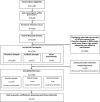Women's Understandings and Misunderstandings of Breast Density and Related Concepts: A Mixed Methods Study
- PMID: 35230164
- PMCID: PMC9299527
- DOI: 10.1089/jwh.2021.0343
Women's Understandings and Misunderstandings of Breast Density and Related Concepts: A Mixed Methods Study
Abstract
Background: Most U.S. states require written notification of breast density after mammograms, yet effects of notifications on knowledge are mixed. Little is known about potential misunderstandings. Methods: We used a sequential mixed-methods study design to assess women's knowledge about breast density, after receiving a notification. We conducted a telephone survey among a racially/ethnically and health-literacy level diverse sample (N = 754) and qualitative interviews with 61 survey respondents. Results: In survey results, 58% of women correctly indicated that breast density is not related to touch, with higher accuracy among non-Hispanic White women and those with greater health literacy. Next, 87% of women recognized that breast density is identified visually via mammogram, with no significant differences in responses by race/ethnicity or health literacy. Most (81%) women recognized that a relationship exists between breast tissue types and density; Non-Hispanic White women were less likely to respond correctly. Only 47% of women correctly indicated that having dense breasts increases one's risk of breast cancer; women with low health literacy were more often correct. Qualitative results revealed additional dimensions of understanding: Some women incorrectly reported that density could be felt, or dense breasts were lumpier, thicker, or more compacted; others identified "dense" tissue as fatty. Interpretations of risk included that breast density was an early form of breast cancer. Conclusion: We found areas of consistent knowledge and identified misperceptions surrounding breast density across race/ethnicity and health literacy levels. Further education to address disparities and correct misunderstandings is essential to promote better knowledge, to foster informed decisions.
Keywords: breast density; dense breast notifications; mammography; patient health beliefs.
Conflict of interest statement
P.J.S., Co-author on an UpToDate article on Breast density and screening for breast cancer, for which she receives royalties. No competing financial interests exist for the other authors.
References
-
- DenseBreast-Info.org. DenseBreast-Info.org. 2021. Available at https://densebreast-info.org Accessed June 22, 2021.
-
- U.S. Food and Drug Administration. Mammography Quality Standards Act. 2019. Available at https://www.federalregister.gov/documents/2019/03/28/2019-05803/mammogra... Accessed July 27, 2020.
Publication types
MeSH terms
Grants and funding
LinkOut - more resources
Full Text Sources
Medical


